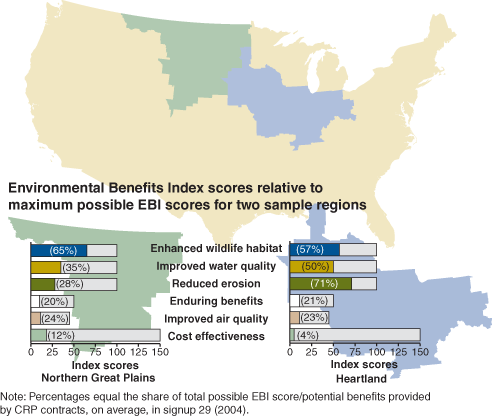Behind The Data
- by Cynthia Nickerson
- 6/1/2006
Measuring Potential Environmental Benefits in the CRP
Typically, programs to improve environmental performance on agricultural lands have multiple objectives, such as improving water quality and wildlife nesting grounds, and seek to achieve these objectives at the lowest cost. These programs often rely on voluntary participation and cost sharing to achieve these objectives. This means program managers need some way of choosing which program applications to enroll. An index that combines information about disparate environmental objectives and cost can serve this purpose. It can also be used to signal how well program objectives may be met.
USDA’s Farm Service Agency (FSA) uses the Environmental Benefits Index (EBI) to evaluate and rank land offered for enrollment in the Conservation Reserve Program (CRP). The EBI aggregates different environmental objectives and a cost objective into a single number.
Points are first allocated to each objective based on the relative benefits of obtaining that objective. For example, the EBI in the 29th signup in 2004 included five environmental objectives. Three of these—enhancing wildlife habitat, improving water quality, and reducing erosion—were expected to provide relatively equal benefits and each was assigned 100 points, out of a total of 545 points. Improving air quality was expected to provide relatively fewer benefits, and this objective was allocated 45 points.
When an applicant offers to implement cover practices in any given signup, FSA evaluates them and assigns points based on the potential environmental benefits to be generated, or how well the practices are likely to contribute to each objective during the time the land is enrolled in the program. For example, an offer to plant a mixed stand of native grasses might earn 50 out of 100 points toward enhancing wildlife habitat, whereas planting one type of an introduced grass species might earn only 10 points. For each signup, FSA totals the points each offer earns toward each objective into a single summary EBI score. Offers are then enrolled based on which have the highest EBI scores until the program acreage cap is reached.
The EBI reflects nationally determined priorities, and the same EBI is used to evaluate and enroll offers from across the country at the end of each signup. However, analysis of CRP data reveals that contracts vary by region in the environmental objectives they address. Even when contracts in different regions address the same objectives, contracts can have very different index scores, meaning they are likely to provide different levels of benefits in different regions. Scores for individual objectives, and thus potential benefits, can vary across regions due to inherent differences in land quality, as well as in the types of practices that producers find profitable to implement in exchange for the program payment.
EBI scores for each objective also reveal how much of the total possible benefits are likely to be achieved in the signup. Regions with contracts that average 50 out of 100 points for a particular objective provide 50 percent of that objective’s total potential benefits.
This article is drawn from:
- Cattaneo, A., Hellerstein, D., Nickerson, C. & Myers , C. (2006). Balancing the Multiple Objectives of Conservation Programs. U.S. Department of Agriculture, Economic Research Service. ERR-19.
You may also like:
- Environmental Benefits Index. (1998). USDA, Farm Service Agency.


